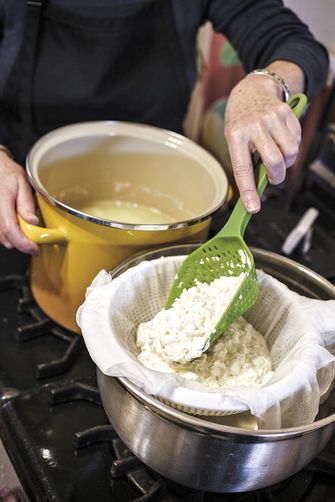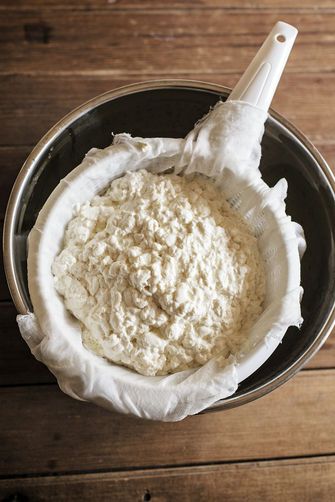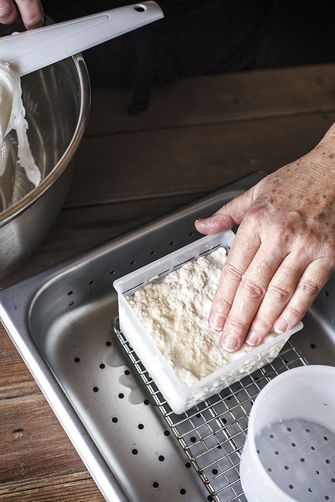It's always more fun to DIY. Every week, we'll spare you a trip to the grocery store and show you how to make small batches of great foods at home.
Today: With some special ingredients and a bit of patience, you can easily make crumbly, salty feta cheese at home. Mary Karlin, author of Mastering Fermentation, shows us how.
Feta cheese is one of the most popular and easy-to-make cultured cheeses: it requires a minimal amount of cheese making skill and offers rewarding, delicious results. It can be made either firm or crumbly in texture, depending on your preference and the type of cheese culture used. Whether brine-cured or dry-salted, feta is most often used crumbled, cubed, or cut into slabs. It can hang out in a big block with sliced cucumbers, Kalamata olives, raw red onions, and tomatoes, or sprinkled over a big green salad. You can bake it with honeyed strawberries for a sweet-meets-tangy dessert or even use the brine to make some of our editors’ favorite martinis.
Due to the amount of time feta spends in a salty liquid, much of its own moisture has been drawn out into the brine. This makes the cheese crumbly and difficult to melt; think of it as an ingredient or a garnish. It can be added to a savory stuffing in roasted or grilled meat, fish, poultry, or vegetables; folded into the batter of corn bread; or tossed into an orzo salad. If the feta has been firmly pressed when made, it can be cut into chunks, brushed with olive oil and then grilled in a kebab.
When allowed to age and dry in the refrigerator, the feta’s saltiness will dissipate, rendering the cheese grateable and more delicate in flavor. Grate a little feta dust on hot, grilled herb flatbread, and serve with smoky wood-roasted peppers for a delicious casual lunch. This is a great preparation for anyone who isn’t so totally obsessed with the cheese (but please, raise your hand if that’s you because I’d like to have a word).
Feta cheese has always been popular, especially in Greek and other Mediterranean cuisines, but it claimed a new place as the most talked-about cheese in early 2021 after a recipe for baked feta pasta went viral on TikTok. The one-pan recipe called for nestling a block of feta cheese in a pool of cherry tomatoes drizzled with olive oil. The two were baked until the cheese became soft and creamy, and the tomatoes were bursting at the seams with their sweet juices. Cooked pasta was added to the baked mixture and soon enough, it seemed that home cooks everywhere were trying out the recipe.
Feta also pairs nicely with a sweet counterpoint. Think flavorful honey drizzled over grilled stone fruit or figs, topped with crumbled feta. During warm weather, it can be cubed or crumbled and then tossed in with peak-of-season tomatoes, basil, and watermelon. Add minced jalapeño for some heat if you choose.
More: Drizzle your feta with thyme-infused honey.
Because feta has been cured with salt, little additional salt is needed when cooking with it. If the feta is too salty for you, gently rinse off the exterior brine or soak in cold water before using. Safe to say that there are nearly infinite uses for feta that will carry you through every meal, including drinks and desserts. But let’s get into how to make homemade feta cheese.
Note: Specialized cheese-making ingredients and supplies (like the starter and lipase powder needed for this recipe) can be purchased online from The Beverage People. Other resources can be found here.
This recipe yields one pound of feta. Here’s what you’ll need to make it:
1 gallon pasteurized whole goat milk
1/8 teaspoon mild lipase powder, dissolved in 1⁄4 cup cool nonchlorinated water 20 minutes before using
1/4 teaspoon direct-set mesophilic starter (preferably ?MM 100 or MA 011)
1/4 teaspoon liquid calcium chloride, diluted in 1⁄4 cup cool, nonchlorinated water
1/2 teaspoon liquid rennet, diluted in 1⁄4 cup cool, nonchlorinated water
2 to 4 tablespoons flaky or kosher sea salt
10 ounces kosher salt (preferably Diamond Crystal) dissolved in 1⁄2 gallon cool, nonchlorinated water and chilled to 55° F (optional, for brine)
First, heat milk and diluted lipase in a pot until they reach 86° F. Sprinkle the starter over top, and after two minutes, whisk to combine. Cover, maintaining a temperature of 86° F, and allow the milk to ripen for one hour. During this time, you can look at all of our favorite feta recipes and decide which one you’re going to make first using your fresh cheese. Whisk in the diluted calcium chloride for a few minutes, then whisk in the rennet.
Cover and allow to sit at 86° F for one hour. Once your curds solidify and the whey has floated to the top, cut the curds into cubes. Let sit for 10 more minutes at 86° F.
Using a flexible rubber spatula, gently stir the curds for 20 minutes, raising the temperature to 90° F. This will release more whey and keep the curds from matting together. The curds will look more pillow-like in shape at the end of this process. Let them rest for five minutes, undisturbed; they will settle to the bottom of the pot.


Line a strainer with dampened cheesecloth or butter muslin, leaving excess cloth hanging over the sides of the strainer. Using a slotted spoon, spoon the curds into the prepared strainer.
Tie the corners of the cloth together to create a draining sack, slip a wooden spoon handle through the knot, and hang over a deep cooking pot or bucket to drain for 10 minutes. Transfer the curds from the cheesecloth to a square feta cheese mold, press them into the corners, generously salt the surface, and allow to finish draining. After one hour, flip the cheese over, return to the mold, and generously salt the surface again. This will help even out the texture and firm the cheese. Cover the molds with cheesecloth and allow to drain at room temperature for eight hours or overnight.


Cut the cheese into 1 1/4-inch slices, and then cut again into cubes. Sprinkle with salt, making sure all the surfaces are covered. Loosely cover the bowl with a lid or plastic wrap and allow to age in the salt for five days in the refrigerator. The cheese can be covered with brine at this point for 21 to 30 days to further cure and add saltiness. If the finished cheese is too salty for your taste, set the cheese in nonchlorinated water for one hour, then drain before using.


See the full recipe (and save and print it here).
This recipe comes from Mary Karlin's book Mastering Fermentation (Ten Speed Press).
This post was updated in January 2022 to include additional copy from our editors.








See what other Food52 readers are saying.